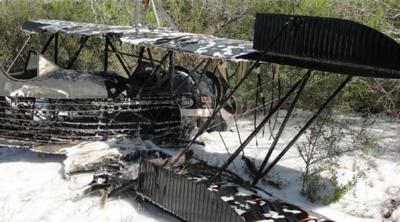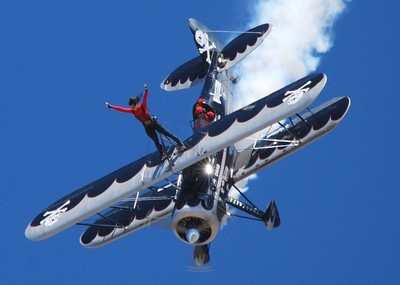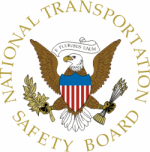Board Could Not Find A Definitive Reason For Kyle And Amanda's
Airplane To Lose Power
The NTSB has released what many will likely find to be an
unsatisfying probable cause report in the accident which eventually
cost Amanda Franklin her life. In its official report, the board
said the airplane lost engine power "for undetermined reasons."
Photo From NTSB Report

According to the NTSB report, Kyle Franklin told the board the
airplane was transported to the air show venues via trailer and
then assembled as necessary for flight. The day prior to the
accident, he completed a solo air show performance and during the
taxi back to the ramp with the throttle at the idle position, the
engine quit. The airplane was towed to the ramp for inspection.
After completing a visual inspection of the engine with no problems
noted, Kyle test-ran the engine at various power settings for
approximately 15 minutes. No anomalies with the engine were noted
during the test run.
Approximately one hour before the accident flight, Kyle
completed a solo air show performance with no anomalies.
A preflight inspection was conducted about 20 minutes prior to
the wingwalker performance flight and no discrepancies were found.
Approximately 15 minutes prior to takeoff, the airplane's engine
was started, and it ran without any problems. Prior to takeoff, an
engine run-up and magneto check were conducted with no
discrepancies noted. During the first 4 to 5 minutes of the
wingwalking performance flight, Kyle said he noted no abnormal
engine instrument readings or engine operations. About 5 minutes
into the flight, the engine lost power. An attempted engine restart
was unsuccessful. Kyle then signaled to Amanda to enter the forward
cockpit, and he executed a forced landing to vegetation-covered
terrain adjacent to the runway.
Witness videos and still photograph images showed the airplane
was maneuvering in a shallow climb when the engine lost power.
Several images show fire and smoke emanating from the engine
exhaust during the engine power loss.
Kyle reported that during the flight, the engine power was set
at maximum, which was 36 inches of manifold pressure and 2,300 RPM.
The pilot did not change the engine power configuration during that
portion of the wingwalker performance. In addition, the airplane's
fuel tank was topped off prior to each of the 2 solo and wingwalker
flights.

Kyle holds a commercial pilot certificate with a single-engine
land rating. The pilot's second class medical certificate was
issued on April 2, 2010. The pilot reported 2,273 total flight
hours of which 728 were in the accident airplane.
A review of the airframe and engine maintenance records showed a
major overhaul on the Pratt & Whitney R-985 AN-14B engine
(serial number 11482) was completed on November 6, 2009, at an
engine total time of 8,204.45 hours, and was installed on the
airframe on January 22, 2010. The Bendix RS-10B2 (part number
391783-4, serial number 638) servo fuel injector was overhauled on
January 18, 2010.
The most recent conditional inspection was completed on January
22, 2010, at a total airframe time of 4,222.3 hours, and a HOBBS
time of 223.3 hours. The pilot reported on the National
Transportation Safety Board (NTSB) aircraft accident form the most
recent conditional inspection was completed on February 19, 2011,
at a total airframe time of 4,261 hours. On February 28, 2011,
which was the last entry in the engine logbook, the number 9
cylinder was removed due to a problem with the exhaust valve,
repaired, and reinstalled, at a HOBBS time of 285.2 hours, and 40.2
since major overhaul. The pilot reported the airplane had
accumulated approximately 3 flight hours at the time of the
accident since the completion of his 2010 air show events.
Examination of the airplane by an FAA inspector revealed the
fuselage sustained fire damage aft of the engine firewall. The main
landing gear collapsed and the airplane came to rest upright. An
unspecified amount of fuel was noted in the center wing fuel tank.
A fitting on the smoke oil system was found fractured and separated
from the respective connection.

Kyle, located in the rear seat, sustained facial injuries and
briefly lost consciousness after the impact. Shoulder harnesses
were not available in the rear seat, and the pilot was not wearing
a helmet. Kyle exited the airplane and attempted to extricate
Amanda from the front seat. He reported the electric smoke oil pump
was continuing to operate after the airplane came to rest. The
smoke oil pump ON/OFF switch was located in the rear seat
compartment, and the pilot did not recall turning the switch OFF
prior to exiting the airplane.
The front seat, which was comprised of the smoke oil container
and a lap belt restraint, was the position the wingwalker sat
during the takeoff and landing phases of flight. After the impact,
rescue personnel arrived at the airplane and assisted the pilot in
attempting to extricate Amanda. She was restrained in the front
seat area via the tethering cable that was used for safety purposes
during the wingwalking activity. Rescue personnel cut the cable in
order to extricate her, but she sustained burns to
approximately 70 percent of her body and succumbed to her injuries
on May 27, 2011.
On April 4, 2011, at the facilities of Tulsa Aircraft Engines,
Tulsa, Oklahoma, the engine and fuel system components were
examined by the NTSB investigator-in-charge. Examination of the
engine showed damage to the number 5 and 6 cylinders. The cylinder
damage was consistent with the impact sequence. The cylinders were
removed and replaced to accommodate an engine functional test. The
servo fuel injector was separated from the engine mount structure
and could not be tested with the engine. A slave carburetor was
installed and the engine was functionally tested for approximately
30 minutes at various power settings with no anomalies noted.

The fuel injector was examined and functionally tested at Mike's
Aircraft Fuel Metering Service, Tulsa, Oklahoma. Visual examination
of the servo showed the mixture control linkage was fractured. The
linkage arm was removed and replaced. All fuel lines and fuel
strainer were found clear of debris. The idle mixture adjustment
was in the mid-range position. The servo was functionally tested in
accordance with the manufacturer approved test procedure. The fuel
servo test was found within limits at the high (full throttle)
setting and slightly rich at the low and mid-range settings. After
the functional test, the fuel servo was partially disassembled. The
regulator lever, which is located between and within the air and
fuel chambers, was found to be bent when rolled on a sheet of
glass. The air chamber was found to be dry and absent of fuel.
The fuel pump was examined and functionally tested at Aircraft
Specialties Services, Tulsa, Oklahoma. No anomalies were noted
during the visual examination. The pump was functionally tested in
accordance with the manufacturer approved test procedure. The fuel
pump functional test was found within specifications.
 ANN's Daily Aero-Term (11.28.25): Unmanned Aircraft System (UAS)
ANN's Daily Aero-Term (11.28.25): Unmanned Aircraft System (UAS) ANN's Daily Aero-Linx (11.28.25)
ANN's Daily Aero-Linx (11.28.25) Airborne 11.21.25: NTSB on UPS Accident, Shutdown Protections, Enstrom Update
Airborne 11.21.25: NTSB on UPS Accident, Shutdown Protections, Enstrom Update Airborne 11.26.25: Bonanza-Baron Fini, Archer v LA NIMBYs, Gogo Loses$$$
Airborne 11.26.25: Bonanza-Baron Fini, Archer v LA NIMBYs, Gogo Loses$$$ Airborne-NextGen 11.25.25: EHang Manned Flt, Army UAVs, Starship V3 Booster Boom
Airborne-NextGen 11.25.25: EHang Manned Flt, Army UAVs, Starship V3 Booster Boom






